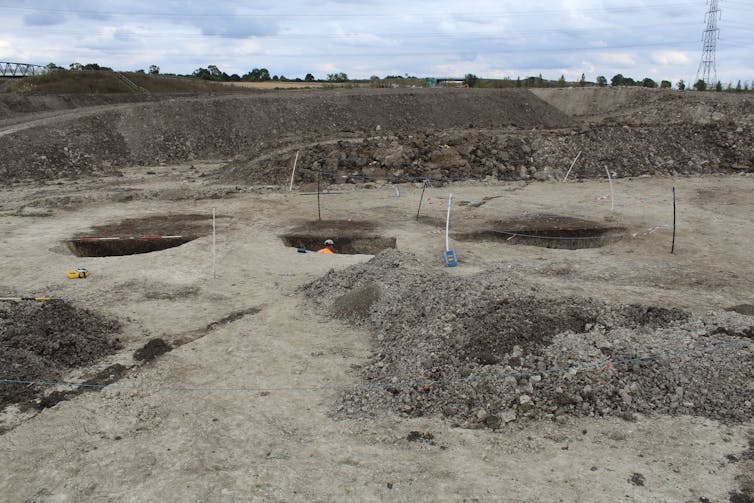In Britain, the Mesolithic period (10BC to 4000BC) was the last time people lived exclusively as hunter-fisher-gatherers. The recent discovery and excavation of a series of large Mesolithic pits at Linmere, Bedfordshire, is important for rethinking how historians have previously considered life and society during this period.
Twenty-five monumental pits, up to 5m wide and 1.85m deep, have been identified in a series of linear alignments, probably extending beyond the excavated area. Radiocarbon dating on associated bones, including deer, marten and auroch (massive, extinct wild cattle), indicate that these pits were dug 8,500 years ago. Their purpose is unclear, but they show signs of having been re-excavated, perhaps over many centuries. This suggests that they were of considerable continued importance.
Mesolithic archaeology in Britain has, historically, largely been understood through finds of stone tools. These finds have the context of massive environmental change over 6,000 years – from final deglaciation, to reforestation and separation from the continent due to rising sea levels, all in the wake of the last ice age.
Other materials, including wood and bone, have been found at sites such as the wetland Star Carr in north Yorkshire and submarine Bouldnor Cliff just off the shore of the Isle of Wight. These have provided a clearer insight into Mesolithic life, but such sites are rare.
The Mesolithic’s image problem
Recent archaeological work has sought to provide greater nuance to this block of time. But the pronouncement of the early and influential archaeologist Mortimer Wheeler in 1954, that Mesolithic people were “as squalid a huddle of marsh-ridden food gatherers as the imagination could encompass” has cast a long and unwarranted shadow over this period.
Mola
The following Neolithic period (4300BC to 2000BC), in contrast, is characterised by a shift to farming and a penchant for monumental architecture. In terms of economy, settlement dynamics and relations to the wider world, it is often seen as a marked departure from the preceding Mesolithic period. As one archaeologist pithily remarked: “[Neolithic] farmers have social relations with one another while [Mesolithic] hunter-gatherers have ecological relations with hazelnuts.”
Today there is mounting evidence of substantial built Mesolithic structures, including houses from the 9th millennium BC, found at Star Carr. Previously regarded as extremely rare, some of these structures, such as those at Howick, Northumbria, may have served multiple generations.
In this context, the alignment of four large Mesolithic pits (previously interpreted as totem pole holes) near Stonehenge is perhaps not as unusual as originally thought. Their structured arrangement was maintained for centuries, in contrast to many smaller individual Mesolithic pits found elsewhere.

Mola
More intriguing, perhaps, is the comparison with the curved pit alignment at Warren Field, Aberdeenshire. Here, individual pits of 2.5m wide date from between 8210BC and 6690BC. Their orientation suggests a significant link with the midwinter solstice. In Britain, such practices have usually been associated with the belief systems of sedentary farming communities.
Re-dug and maintained over millennia, the pits at Warren Field may be evidence for the longest-functioning prehistoric structures in Britain. The pits here – as at Linmere – were originally presumed to be Neolithic until radiocarbon dating proved otherwise. How many similar features may pass without notice, on the presumption that they are from a later time, can only be guessed.
What Linmere tells us about Mesolithic people
Linmere, like so many important archaeological sites in Britain, was discovered through commercial archaeology, conducted ahead of construction and development. Britain excels in such work, although the limits on resources available for such investigations prevent a complete picture of the extent or character of the Linmere pits.
However, they attest to the diversity of pit use during the Mesolithic period and further show that some pits were set apart by their structure, scale and lasting interest.
The repeated attention and action of communities over centuries suggests enduring symbolism and underlying world views that archaeologists had previously tended to associate with farming communities, rather than Britain’s prehistoric hunter-gatherers.
Though we still don’t know what these pits were for, they add to a small but growing body of evidence attesting to the unique, complex and intriguing social and belief structures of Mesolithic hunter-gatherers living on the edge of Europe.

Looking for something good? Cut through the noise with a carefully curated selection of the latest releases, live events and exhibitions, straight to your inbox every fortnight,
on Fridays. Launches August 4. Sign up here.




